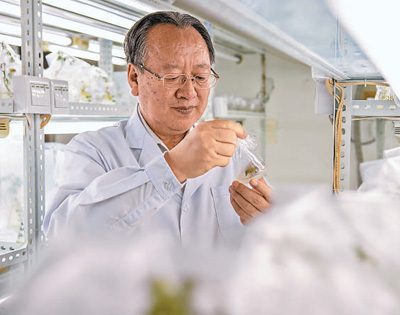(Peoples Daily Online)13:10, August 03, 2020![]()
For decades, Li Tianlai, an expert in solar greenhouses, has been working to help more residents in northern China cultivate vegetables and fruit in winter.

Li Tianlai (File photo)
He has pioneered the theories and methods for maintaining good lighting procedures as well as storing and preserving heat in greenhouses, enabling northern areas, where temperatures can fall to minus 30 degrees Celsius in winter, to plant fruit and vegetables through the use of solar energy.
Li has also successfully brought the line demarcating areas where fruit and vegetables can be grown in winter 300 kilometers farther north.
In 1978, he entered the Shenyang Agricultural University, specializing in studying how to grow vegetables. Agriculture integrates many disciplines, such as genetics, breeding, cultivation, and soil nutrition, and turned out to be more interesting than I thought, he said.
While still at school, Li spent a lot of time in the fields, which made him realize the importance of combining practice and research.
After graduation, he was persuaded by his teachers to stay and teach at the school. I was determined to conduct scientific research and continue with my studies while teaching, he said.
He would often carry out experiments in the fields, learn from the farmers, and managed to solve the problems they frequently encountered in their work.
In 1985, Li went to Japan to study horticulture at Yamagata University. Three years later, he returned to China and started to address the urgent problem of residents in northern China finding it difficult to get fresh fruit and vegetables in winter.
Li decided to try striking a balance between input and output, and developed a program that was more accessible to farmers and that could be promoted on a large scale after initial results.
Li and his research team have implemented innovations to maintain lighting and heat at the same time, not an easy task for most horticultural facilities.
Due to the lack of funds, the research team asked the farmers to demonstrate and promote the program. Members of the team held training courses and provided on-site guidance, finally achieving initial results.
In 1988, Li participated in the design and construction of the first-generation solar greenhouse, allowing northern regions where temperatures can fall to minus 20 degrees Celsius in winter to plant fruit and vegetables by making use of solar energy.
He would later continue to improve the technologies, expanding the areas able to grow vegetables in winter from 40.5 degrees north of the Earths equatorial plane to 43.5 degrees.
Li is now developing modern solar greenhouses, which are expected to automatically control the environment in the greenhouses and be equipped with machinery production.

